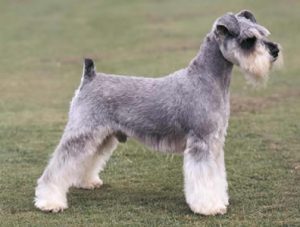
The Miniature Schnauzer is a breed of small dog of the Schnauzer type that originated in Germany in the mid-to-late 19th century. Miniature Schnauzers developed from crosses between the Standard Schnauzer and one or more smaller breeds such as the Poodle or Affenpinscher.
The breed remains one of the most popular, and as of 2008 is the 11th most popular breed in the U.S, primarily for its temperament and relatively small size. The American Kennel Club recognises only three colours for the Miniature Schnauzer: salt-and-pepper, black-and-silver, and solid black. Solid white is considered a disqualification, although, a small patch of white is allowed on the solid black. In the United Kingdom, the small white patch on a solid black is also considered a fault. Colours such as white, parti (multi), chocolate and liver are available on the pet trade and can be registered as pure-breds by some organisations, but are not currently recognised by any legitimate clubs for conformation shows.
Appearance
Miniature Schnauzers normally have a small, squarely proportioned build, measuring 12 to 14 inches (30 to 36 cm) tall and weighing 11 to 15 pounds (5.0 to 6.8 kg) for females and 14 to 18 pounds (6.4 to 8.2 kg) for males. They have a double coat. The exterior fur is wiry and the undercoat is softer. The coat is trimmed short on the body, but the hair on ears, legs, and edge of the body, a.k.a. the “furnishings”, are retained. The first Breed Standard for the Schnauzer, established in 1907, required specific colour formation: “Colour: All salt and pepper colour shades or similar bristly equal colour mixtures and solid black. Faults: …All white, speckled, brindles, red, or bran colours.”
Miniature Schnauzers are often described as non-shedding dogs, and while this is not entirely true, their shedding is minimal and generally unnoticeable. They are characterised by a long head with bushy beard, moustache and eyebrows; teeth that meet in a “scissor bite”; oval and dark coloured eyes; and v-shaped, natural forward-folding ears. (When cropped, the ears point straight upward and come to a sharp point.) Their tails are naturally thin and short, and may be docked (where permitted). They will also have very straight, rigid front legs, and feet that are short and round (so-called “cat feet”Wink with thick, black pads.
Temperament
The Official Standard of the Miniature Schnauzer describes temperament as “alert and spirited, yet obedient to command. He is friendly, intelligent and willing to please. He should never be overaggressive or timid.” Usually easy to train, they tend to be excellent watchdogs, with a good territorial instinct, but more inclined toward vocal notification than attack. They are often guarded towards strangers until the owners of the home welcome the guest, upon which they are typically very friendly to them; unlike some of their terrier cousins, they are not typically aggressive. However, they will express themselves vocally, and may bark to greet their owner, or to express joy, excitement, or displeasure.
Proper socialisation with other dogs and people is important. The breed is generally good with children, but as with any dog, play with small children should be supervised. They are highly playful dogs, and if not given the outlet required for their energy they can become bored and invent their own “fun.” Schnauzers have a “high prey drive” (appropriate for a ratting dog), which means they may attack other small pets such as birds, snakes, and rodents. Many will also attack cats, but this may be curbed with training, or if the dog is raised with cats.
—————————————————————————————————————–
CARING FOR YOUR DOG NEWSLETTER – Delivered Directly To Your Inbox – Starting Immediately – SIGN UP FOR FREE TODAY
—————————————————————————————————————–
